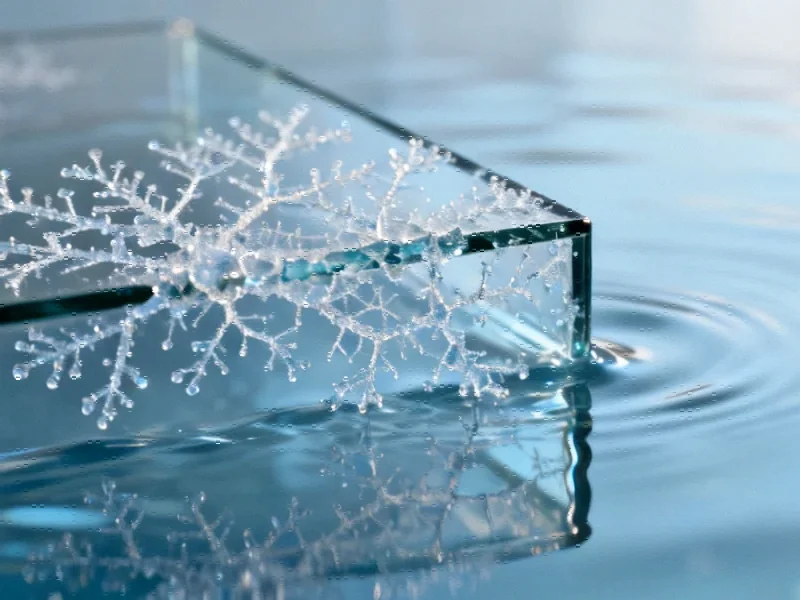Breakthrough in Glass Corrosion Understanding
Researchers have developed new theoretical models that provide unprecedented insights into the aqueous corrosion mechanisms of silicate glass, according to recent reports in npj Materials Degradation. The study addresses fundamental questions about how common glass materials degrade when exposed to water and acidic solutions, with significant implications for numerous industrial applications.
Moving Boundary Transport Models
The research team modeled incongruent corrosion as a moving-boundary transport problem, where the moving boundary contributes convective transport while ion exchange provides diffusive transport. Sources indicate they solved the convection-diffusion transport equation using two distinct approaches: one coupling the moving boundary to the diffusion process, and another with an independent moving boundary trajectory.
Analysts suggest these models successfully replicate the aqueous corrosion behavior of soda lime silica (SLS) glass in both neutral and acidic conditions. The report states these findings challenge conventional interpretations of sigmoidal sodium concentration profiles observed at glass surfaces, which the researchers attribute to Gaussian convolution from experimental methods rather than concentration-dependent diffusion coefficients.
Primary Corrosion Drivers Identified
Through fitting experimental data with physically meaningful transport models, researchers reportedly discovered that the driving force for sodium diffusion and leaching from glass originates from the ingress of hydrous species into the SLS structure. According to the analysis, this represents a paradigm shift from previous theories that emphasized concentration gradients of sodium as the primary driver.
The study distinguishes between different corrosion mechanisms based on pH conditions. In neutral environments, H₂O serves as the main hydrous species driving the process, while in acidic conditions, H⁺ ions become the dominant species facilitating corrosion. This understanding of mass diffusivity mechanisms provides crucial insights for material scientists working on glass durability.
Limitations of Traditional Models
The research highlights significant shortcomings in the two most frequently utilized models for understanding glass corrosion. Fick’s second law of diffusion, while conceptually simple and widely applied, reportedly fails to account for systems where the glass matrix undergoes alteration through dissolution or swelling. Analysts suggest this limitation becomes particularly problematic when modifier ion leaching accompanies network dissolution or gel layer formation.
The Doremus model of interdiffusion, while incorporating charge neutrality considerations, faces its own constraints. Sources indicate this model assumes constant corrosion rates and relies on concentration-dependent interdiffusion coefficients that may not accurately represent physical reality. The new research questions whether sigmoidal concentration profiles truly indicate concentration-dependent behavior or simply reflect experimental artifacts.
Industrial Applications and Implications
The improved understanding of silicate glass corrosion has broad implications across multiple industries. From nuclear waste vitrification to architectural applications and consumer packaging, the durability of silicon dioxide-based materials affects product performance and safety. The research comes amid broader industry developments in materials science and manufacturing processes.
As companies invest in recent technology for material analysis and product development, these findings could influence how glass manufacturers approach durability testing and material selection. The study’s methodology also aligns with growing interest in related innovations in computational materials science.
Environmental and Economic Considerations
The research emerges alongside increasing attention to sustainable material use and repurposing of industrial sites, including market trends in industrial redevelopment. Understanding glass corrosion mechanisms becomes particularly important for long-term storage applications and environmental containment systems.
According to reports, the new models provide a more accurate framework for predicting glass behavior over extended timeframes, which could influence how industries approach material selection for corrosive environments. The constant diffusion coefficient approach successfully explains experimental data from neutral pH conditions, while the numerical solution with constant dissolution rate satisfactorily models sodium leaching in acidic environments.
Future Research Directions
The study opens new avenues for investigating glass corrosion phenomena, particularly regarding the interaction between diffusion processes and structural changes in the glass network. Researchers emphasize the importance of accounting for experimental artifacts before attributing physical significance to observed concentration profiles.
As materials science continues to evolve alongside recent technology advancements, these findings provide a solid foundation for developing more accurate predictive models of material degradation. The integration of theoretical modeling with experimental validation represents a significant step forward in understanding and controlling glass corrosion processes across diverse applications.
This article aggregates information from publicly available sources. All trademarks and copyrights belong to their respective owners.
Note: Featured image is for illustrative purposes only and does not represent any specific product, service, or entity mentioned in this article.
